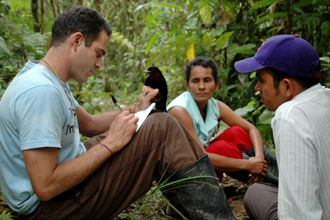Symbiotic survival of rare birds and rain forests
On the coast of Ecuador, along the Pacific Ocean, on the western side of the Andes Mountains, lies the Choco rain forest. Here, Jordan Karubian, his students and local residents, whom he's enlisted as “environmental ambassadors,” study an endangered species of bird the long-wattled umbrellabird.

Jordan Karubian, left, assistant professor of ecology and evolutionary biology, records the activities of a Choco rain forest bird with assistance from Ecuadorans Rosa and Jorge. (Photo from Jordan Karubian)
He is researching the mating habits, seed-dispersal activities and migratory patterns of birds in Ecuador, Australia, Papua New Guinea and the Gulf South of the United States.
The birds that Karubian studies dwell in fragile ecosystems that are in peril. And he has discovered that to have a lasting impact on protecting the birds and their habitats from disappearance, he must do more than function as a traditional researcher.
He's engaged members of the community, especially in Ecuador, as research assistants and educators in local schools. And he's encouraged his Tulane students as service learners in conservation efforts that go beyond measuring and collecting data.
In the Choco region, slash-and-burn subsistence practices have been destroying rain forest trees at alarming rates.
Since he's involved local residents in research and education projects during the past decade, “there has been a significant shift in the way people perceive the consequences of their actions,” says Karubian.
People are becoming aware that “for their own selfish, long-term interests, they need to take care of where they live.”
In recognition of his work as a scientist and a conservationist, Karubian is the recipient of the 2012 Ernest Lynton Award for the Scholarship of Engagement for Early Career Faculty from the New England Resource Center for Higher Education.
